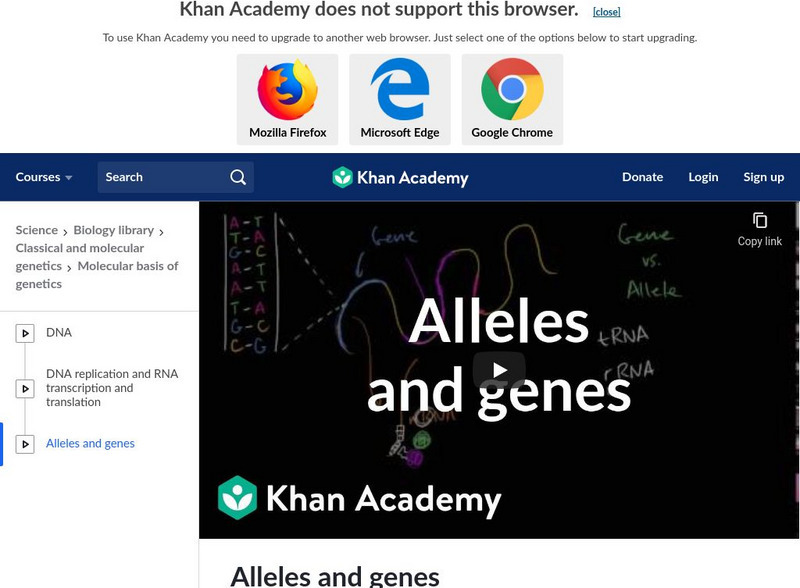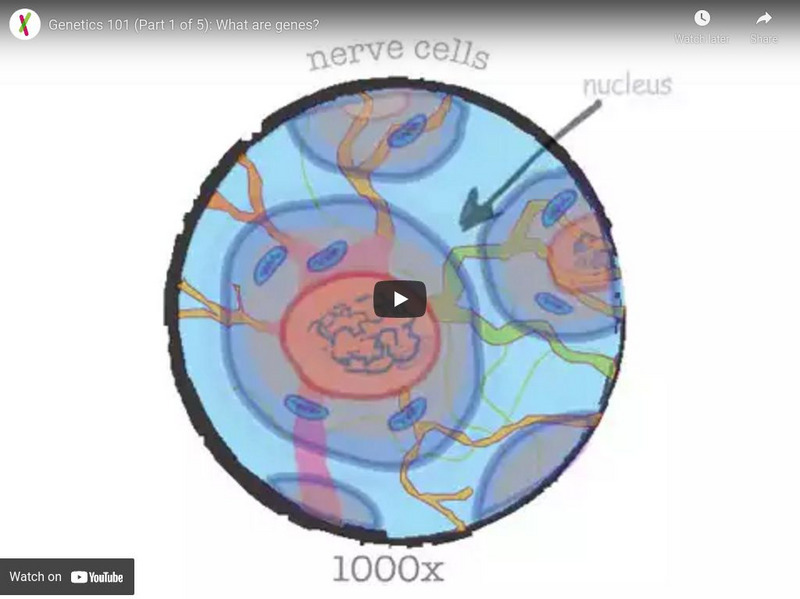Hi, what do you want to do?
Teacher's Pet
Genes and Chromosomes
Doctors sometimes order a karyotype, a picture of the chromosomes present in a single cell, in order to check for chromosomal abnormalities or rare diseases. The video explains the relationship among genes, chromosomes, and karyotypes....
Howard Hughes Medical Institute
The Y Chromosome
Forward and backward, it's all the same! Scientists recently discovered the y chromosome's palindrome nature suggests it's possible to for the y chromosome to recombine with itself! An animation resource gives viewers insight into the...
TED-Ed
Where Do Genes Come From?
No, you didn't get your genes from the local clothing store. Learn where they really come from by watching this video as it explores how the genes found in all plants and animals today have arisen over...
Amoeba Sisters
DNA Structure and Function
Chromosomes come in pairs and in pears. The video covers DNA structure and function including the parts of the nucleotide and the four bases. It provides examples of cloning, gene regulation, and mutation.
American Museum of Natural History
What Makes YOU YOU? What Makes ME ME?
What does DNA have to do with me? Learners watch a short animated video to learn about cells and DNA. Scholars learn that DNA is the building block of chromosomes within the cells of every living thing.
Bozeman Science
What are Chromosomes?
An informative video begins by showing scholars how chromosomes are like encyclopedias. The instructor then explains and differentiates genome, chromosome, sister chromatids, nucleosomes, DNA, genes, and base pairs.
Amoeba Sisters
Alleles and Genes
How do organisms end up with such a wide variety of traits? It's in their genes! Kick off your inherited traits lesson using a brief video that covers alleles and genes. The narrator describes heterozygous and homozygous genotypes, how...
PBS
DNA 101: Life's Instruction Manual | UNC-TV Science
Unravel the DNA molecule in just over a minute! Future geneticists listen and watch a video exploring DNA's structure, function, and the interaction of the genes and proteins that decode and interpret the complex molecule. Scholars...
Bozeman Science
LS3A - Inheritance of Traits
Construct an inheritance unit that's pure gene-ius! Untangle the vast amount of information found in standard LS3A, Inheritance of Traits. The video shows examples and scenarios suited for all age and ability levels, as well as helpful...
Amoeba Sisters
Mutations: The Potential Power of a Small Change
Are the only mutants you know Ninja Turtles or X-Men? The video explains both gene mutation and chromosome mutation. It includes the subtypes of mutations for each major type, the times when mutations are more likely to happen, and...
SciShow
Why Ferns Have More Chromosomes Than You
Potatoes have more chromosomes than humans. A video explores the number of chromosomes various species have and the theories of the differences. It discusses the process of how genes combine as well as the processes of making extra copies.
Crash Course
Heredity
Ear wax, either wet or dry, is inherited on chromosome 16. The narrator of a video about heredity uses ear wax to introduce the concepts of alleles, dominant and recessive traits, and heterozygous and homozygous genotypes.
Stated Clearly
What Exactly is a Gene?
What is a gene and how do organisms use them? Find out these answers while learning about how humans have modified genes in plants to best suit their own needs and desires. Before watching the video, you may want to show the video about...
Teacher's Pet
Gregor Mendel
What did Gregor Mendel say when he founded genetics? Woopea! The video introduces Gregor Mendel to viewers. It details his initial experiments with peas and his understanding of genetics.
FuseSchool
What Are Chromosomes?
Two meters worth of DNA fits into a cell that is only two micrometers wide thanks to chromosomes. A video, part of a Fuse School Biology playlist, explains what chromosomes are and how they work. It describes where they are found and how...
FuseSchool
What is DNA?
Don't under-strand DNA? Watch an informative Fuse School Genetics video to learn what DNA is and where it is found. It also explains what DNA does, its relationship with genes, the four nucleotides, and their base pairs.
PBS
Genome 101: Life's Instruction Manual | UNC-TV Science
Crack open the mysteries inside a genome. Participants view an animated video describing the relationship between DNA, genes, proteins, chromosomes, and an organism's genome. A post-video worksheet allows pupils to apply knowledge by...
Amoeba Sisters
DNA, Chromosomes, Genes, and Traits: An Intro to Heredity
Chromosomes, genes, traits ... how are they all related? A short video introduces the many factors involved in heredity. Junior geneticists explore the transfer of chromosomes from parents to offspring, the proteins created by base pair...
Howard Hughes Medical Institute
Popped Secret Film with Quiz: The Mysterious Origin of Corn
Where does corn come from? Corn cobs? Scholars watch an interesting video to learn that the ancestor of maize is the teosinte plant. The video goes on to explain how both geneticists and archaeologists have evidence that humans were...
Be Smart
3 Incredible Examples of Evolution Hidden in Your Body
Human traits trace back to simpler species—such as chickens, for example. Using the human genomes, scientists connect these traits to their ancestral origins. A video presentation highlights the structure of human DNA and makes a...
Crash Course
Biotechnology: Crash Course History of Science #40
Biotechnology is a relatively new science, but the history of the science that made it possible goes back to the early 1900s. Take a tour through the history of scientific research that led to the possibility of biotechnology. The lesson...
PBS
How Two Microbes Changed History
Where would we be without bacteria? As it turns out, we owe them everything! Introduce young biologists to endosymbiotic theory using an amazing video from an extensive biology playlist. Scholars discover the bacteria that may be...
Khan Academy
Khan Academy: Alleles and Genes
Learn about the gene as a stretch of DNA on a chromosome. Also find out about alleles as versions or sequence variants of a gene. [8:17]
Khan Academy
Khan Academy: Heredity and Genetics: Genetics 101 Part 1: What Are Genes?
Find out about the basics of cells, chromosomes, and the genes contained in your DNA. [4:26]




























